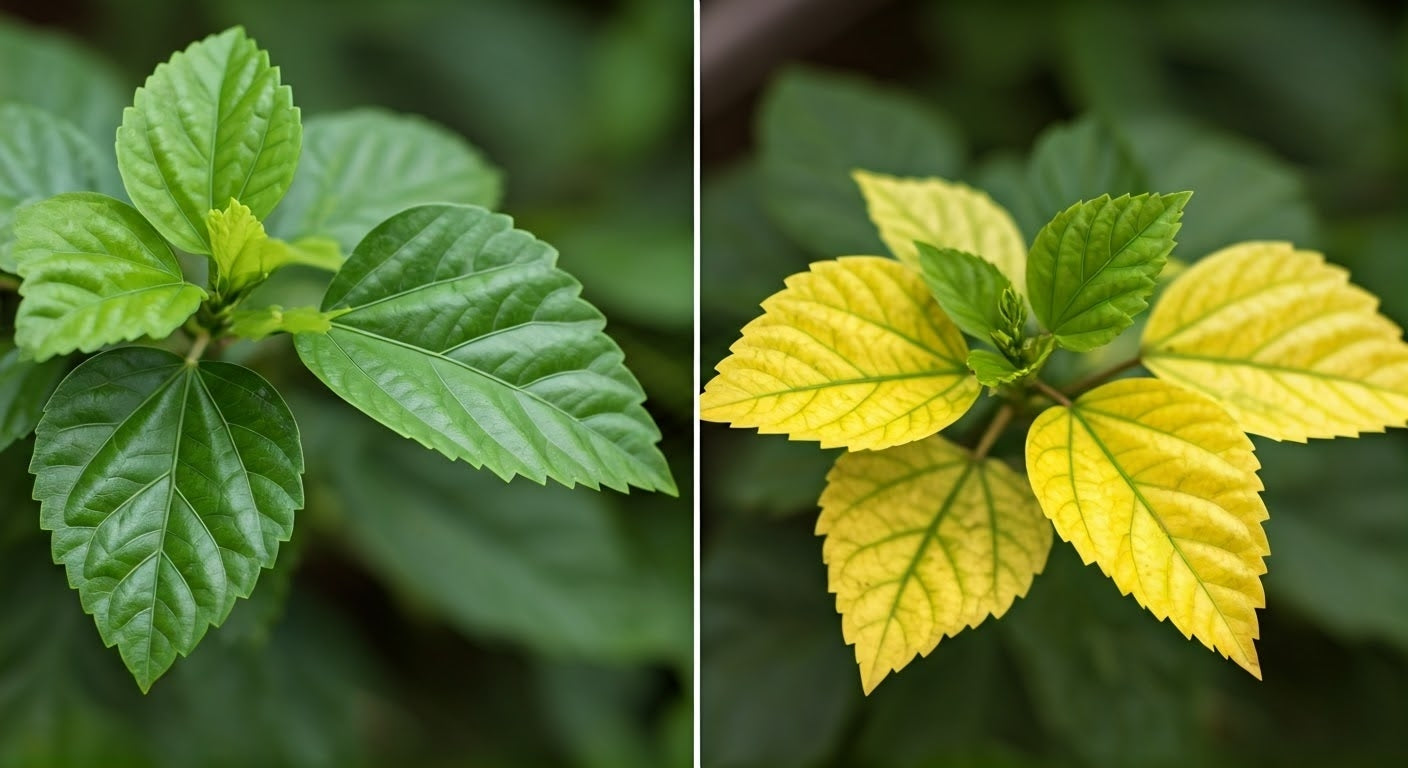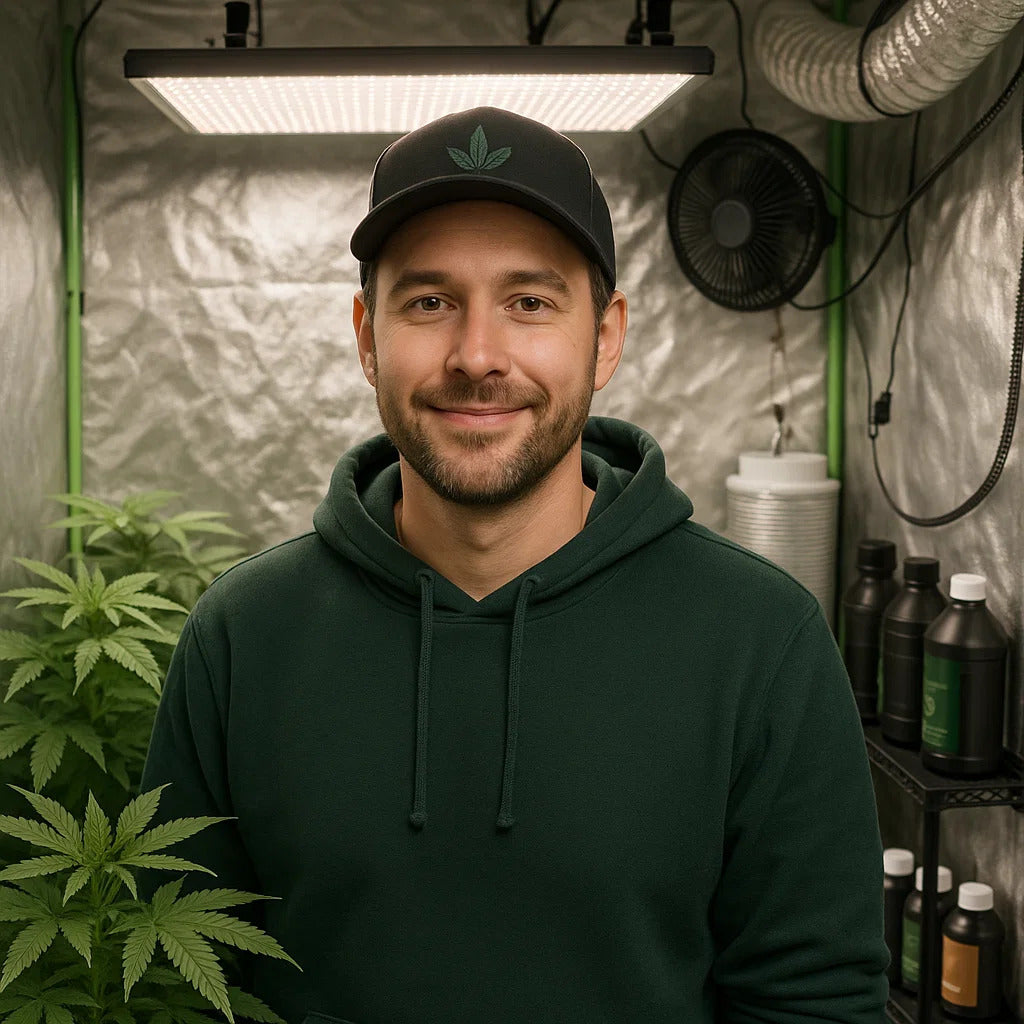
Hibiscus Leaves Turning Yellow: Essential Troubleshooting Guide for Healthy Plants
When hibiscus leaves turning yellow becomes a persistent problem, it signals underlying issues that require immediate attention. This comprehensive guide explores the multiple causes behind yellowing hibiscus foliage and provides practical solutions to restore your plants to vibrant health, whether growing outdoors or in controlled indoor environments.
Understanding why hibiscus leaves turn yellow is crucial for maintaining these stunning flowering plants that grace gardens and indoor growing spaces worldwide. From nutrient deficiencies to environmental stress, multiple factors can contribute to this common but concerning symptom.
Common Causes of Hibiscus Leaves Turning Yellow
Overwatering and Poor Drainage Issues
The most frequent culprit behind hibiscus leaves turning yellow is excessive moisture around the root system. Hibiscus plants require well-draining soil and consistent, moderate watering rather than frequent heavy watering sessions.
Signs of Overwatering:
- Yellowing leaves starting from the bottom of the plant
- Soft, mushy stems near the soil line
- Fungal growth on soil surface
- Wilting despite moist soil conditions
Solutions for Overwatering:
- Reduce watering frequency immediately
- Improve soil drainage with perlite or sand amendments
- Check for root rot and trim affected roots if necessary
- Ensure containers have adequate drainage holes

Nutrient Deficiencies Causing Yellow Leaves
Hibiscus plants are heavy feeders requiring balanced nutrition throughout their growing season. Specific nutrient deficiencies manifest as distinctive yellowing patterns that help identify the underlying problem.
Nitrogen Deficiency:
- Older leaves turn yellow first, progressing upward
- Overall plant appears pale green
- Stunted growth and reduced flowering
Iron Deficiency (Chlorosis):
- New leaves turn yellow while veins remain green
- Upper leaves more affected than lower ones
- Common in alkaline soil conditions
Magnesium Deficiency:
- Yellowing between leaf veins while veins stay green
- Affects older leaves primarily
- Purple or red tinting may appear on leaf edges
Environmental Stress Factors
Environmental conditions play a crucial role in hibiscus health, and sudden changes can trigger widespread leaf yellowing. Indoor hibiscus cultivation allows for better environmental control, making Complete Grow Tent Kits an excellent solution for maintaining optimal growing conditions year-round.
Temperature Stress:
- Sudden temperature drops below 50°F (10°C)
- Excessive heat above 90°F (32°C)
- Rapid temperature fluctuations between day and night
Light-Related Issues:
- Insufficient sunlight (less than 6 hours daily)
- Excessive direct sunlight causing leaf scorch
- Inconsistent lighting schedules for indoor plants
Advanced Troubleshooting for Yellowing Hibiscus Leaves
Pest-Related Yellowing Problems
Several common pests can cause hibiscus leaves to turn yellow through feeding damage or by transmitting plant diseases. Early identification and treatment prevent widespread damage.
Aphid Infestations:
- Small clusters of tiny green, black, or white insects
- Sticky honeydew coating on leaves
- Yellowing and curling of new growth
Spider Mite Damage:
- Fine webbing on undersides of leaves
- Stippled, yellowing appearance on leaf surfaces
- Rapid spread during hot, dry conditions
Whitefly Problems:
- Small white flying insects when plant is disturbed
- Yellowing leaves with eventual leaf drop
- Honeydew production leading to sooty mold

Disease-Related Causes of Yellow Leaves
Fungal Infections
Fungal diseases thrive in humid, poorly ventilated conditions and can rapidly cause widespread leaf yellowing. Proper environmental control through Grow Tent Ventilation Systems helps prevent these issues in indoor growing situations.
Root Rot Symptoms:
- Yellowing progressing from bottom to top
- Brown, mushy roots when examined
- Foul odor from soil when disturbed
- Plant appears wilted despite adequate soil moisture
Leaf Spot Diseases:
- Circular brown spots with yellow halos
- Progressive yellowing and eventual leaf drop
- Higher occurrence during humid weather
- Spread through water splash and poor air circulation
Bacterial Infections
Bacterial problems often enter through wounds or natural plant openings, causing systematic yellowing and decline if left untreated.
Bacterial Wilt Indicators:
- Rapid yellowing and wilting of entire branches
- Brown streaking in stem vascular tissue
- Progressive plant decline despite good cultural care
- Difficulty in reversing once established
Soil and pH-Related Yellowing Issues
Soil pH Imbalance Effects
Hibiscus plants prefer slightly acidic to neutral soil (pH 6.0-7.0). Extreme pH levels prevent proper nutrient uptake, leading to deficiency symptoms despite adequate fertilization.
Alkaline Soil Problems (pH above 7.5):
- Iron and manganese become unavailable
- New growth shows interveinal chlorosis
- Gradual yellowing spreading throughout plant
- Reduced flowering and overall vigor
Acidic Soil Issues (pH below 5.5):
- Aluminum and manganese toxicity
- Phosphorus availability reduced
- Root damage from excessive acidity
- Stunted growth with yellowing older leaves
Soil Compaction and Root Restriction
Compacted soil or rootbound containers restrict oxygen flow to roots, causing stress-related yellowing throughout the plant.
Container Growing Solutions:
- Repot annually with fresh, well-draining potting mix
- Use containers with adequate drainage holes
- Consider fabric grow bags for improved root aeration
- Monitor root development regularly
Seasonal Yellowing Patterns
Natural Autumn Response
As daylight hours decrease and temperatures drop, hibiscus plants naturally begin preparing for dormancy, causing some yellowing of older leaves. This differs from stress-induced yellowing in timing and pattern.
Normal Seasonal Changes:
- Gradual yellowing of oldest leaves first
- Reduced new growth production
- Flower production naturally decreases
- Plant maintains overall health appearance
Winter Care Considerations
Indoor hibiscus cultivation during winter months requires careful attention to environmental conditions. Grow Tent Temperature Control becomes essential for maintaining optimal growing conditions.
Winter Yellowing Prevention:
- Maintain consistent temperatures between 65-75°F
- Provide adequate humidity (40-60%)
- Ensure proper lighting duration and intensity
- Reduce watering frequency during slower growth periods
Professional Solutions for Indoor Hibiscus Growing
Controlled Environment Benefits
Growing hibiscus in controlled indoor environments eliminates many variables that cause leaf yellowing. Gorilla Grow Tent Kits provide comprehensive solutions for maintaining optimal growing conditions.
Environmental Control Advantages:
- Consistent temperature and humidity regulation
- Precise lighting schedules and intensity control
- Protected from pests and diseases
- Year-round growing capability regardless of outdoor conditions
Complete Growing System Benefits:
- All necessary equipment included in single package
- Professional-grade components ensure reliability
- Easy setup and maintenance procedures
- Proven results for flowering plant cultivation
Advanced Growing Techniques
Hydroponic Hibiscus Cultivation:
- Eliminates soil-borne disease problems
- Precise nutrient control prevents deficiencies
- Faster growth rates with proper management
- Reduced pest pressure in controlled environments
Air Circulation Management:
- Prevents fungal disease development
- Strengthens plant stems through gentle movement
- Ensures proper gas exchange around foliage
- Maintains optimal humidity levels throughout canopy
Prevention Strategies for Healthy Hibiscus Plants
Proactive Plant Health Management
Regular Monitoring Schedule:
- Daily visual inspection for early problem detection
- Weekly soil moisture and pH testing
- Monthly comprehensive plant health assessment
- Seasonal adjustment of care routines
Optimal Growing Conditions:
- Maintain soil pH between 6.0-7.0
- Provide 6-8 hours of bright light daily
- Keep temperatures between 65-85°F consistently
- Maintain humidity levels around 50-60%
Nutrition Management Program
Balanced Fertilization Approach:
- Use balanced NPK fertilizer (10-10-10 or similar)
- Apply liquid fertilizer every 2-3 weeks during growing season
- Supplement with micronutrients monthly
- Reduce feeding frequency during winter months
Organic Nutrient Sources:
- Compost application for slow-release nutrients
- Fish emulsion for nitrogen supplementation
- Bone meal for phosphorus availability
- Kelp meal for micronutrient diversity
Treatment Protocols for Yellowing Leaves
Immediate Response Actions
Emergency Assessment Steps:
- Examine soil moisture levels and drainage
- Check for visible pest activity on all plant surfaces
- Assess environmental conditions (temperature, humidity, light)
- Review recent care routine changes or applications
- Document yellowing pattern and progression rate
First Aid Measures:
- Remove severely yellowed or damaged leaves immediately
- Adjust watering schedule based on soil moisture assessment
- Relocate plant if environmental conditions are suboptimal
- Implement pest control measures if insects detected
Long-Term Recovery Plans
Soil Rehabilitation:
- Replace or amend existing growing medium
- Improve drainage with perlite or vermiculite additions
- Adjust pH to optimal range using appropriate amendments
- Introduce beneficial microorganisms through compost additions
Plant Recovery Support:
- Gradually increase fertilization as plant responds
- Monitor new growth for improvement signs
- Maintain consistent environmental conditions
- Avoid additional stress factors during recovery period
Advanced Indoor Growing Solutions
Professional Equipment Integration
For serious hibiscus enthusiasts, investing in professional-grade growing equipment ensures consistent results and eliminates guesswork from plant care.
Complete System Advantages:
- 2x4 Grow Tent Kit provides adequate space for multiple hibiscus plants
- Integrated ventilation prevents fungal diseases
- Precise environmental control eliminates stress factors
- Year-round flowering capability regardless of outdoor conditions
Scalable Growing Options:
- 5x5 Grow Tent Kit accommodates larger hibiscus varieties
- Multiple plant cultivation in single controlled environment
- Professional results achievable by home gardeners
- Long-term investment in consistent growing success
Technology Integration Benefits
Automated Monitoring Systems:
- Continuous temperature and humidity tracking
- Automated watering systems prevent over/under-watering
- Light timing controllers ensure consistent photoperiods
- Alert systems notify of environmental deviations
Data-Driven Growing Decisions:
- Historical growing condition records
- Performance correlation with environmental factors
- Predictive maintenance scheduling
- Optimization based on plant response patterns
Troubleshooting Specific Yellowing Patterns
Bottom-Up Yellowing Progression
Primary Causes:
- Overwatering leading to root oxygen deprivation
- Natural aging of older foliage during active growth
- Nitrogen deficiency in established plants
- Root rot development in early stages
Targeted Solutions:
- Immediately reduce watering frequency
- Improve soil drainage through amendments
- Apply balanced fertilizer with emphasis on nitrogen
- Inspect roots for signs of decay or damage
Top-Down Yellowing Pattern
Likely Culprits:
- Heat stress from excessive light or temperature
- Micronutrient deficiencies, particularly iron
- pH imbalance preventing nutrient uptake
- Sudden environmental changes causing shock
Corrective Measures:
- Provide temporary shade during peak heat hours
- Test and adjust soil pH to optimal range
- Apply chelated micronutrient supplements
- Gradually acclimate plants to environmental changes
Random Yellowing Throughout Plant
Potential Issues:
- Pest activity affecting multiple plant areas
- Viral or bacterial infection spread
- Chemical damage from fertilizer or pesticide burn
- Severe nutrient imbalance affecting entire system
Recovery Strategies:
- Comprehensive pest inspection and treatment
- Quarantine affected plants if disease suspected
- Flush soil to remove excess chemicals
- Restart nutrition program with balanced approach
Long-Term Hibiscus Health Maintenance
Seasonal Care Adjustments
Spring Preparation:
- Gradual increase in watering and fertilization
- Pruning to encourage new growth
- Repotting if root-bound conditions detected
- Introduction of beneficial insects for pest control
Summer Management:
- Increased watering frequency during hot periods
- Shade protection during extreme heat events
- Regular pest monitoring and treatment
- Consistent fertilization to support active growth
Fall Transition:
- Gradual reduction in fertilization frequency
- Preparation for dormancy period
- Final pest control treatments before winter
- Assessment of plant health for indoor overwintering
Winter Care:
- Minimal watering to prevent root rot
- Consistent temperature maintenance
- Adequate lighting for indoor plants
- Monitoring for stress-related yellowing
Creating Optimal Growing Environments
Outdoor Growing Optimization:
- Site selection with morning sun, afternoon shade
- Soil amendment for drainage and nutrition
- Companion planting for natural pest control
- Protection from strong winds and temperature extremes
Indoor Growing Excellence:
- Professional growing equipment investment
- Environmental monitoring and control systems
- Integrated pest management protocols
- Systematic nutrition and care schedules
Maximizing Hibiscus Health and Beauty
Understanding and addressing hibiscus leaves turning yellow requires comprehensive knowledge of plant biology, environmental factors, and proper care techniques. By implementing the strategies outlined in this guide, growers can maintain vibrant, healthy hibiscus plants that produce abundant, stunning blooms throughout the growing season.
The key to preventing yellowing leaves lies in creating and maintaining optimal growing conditions, whether in outdoor gardens or controlled indoor environments. Professional-grade growing systems provide the consistency and control necessary for exceptional results, eliminating the guesswork that often leads to plant stress and yellowing foliage.
Success with hibiscus cultivation comes from understanding that these plants thrive with consistent care, proper nutrition, and stable environmental conditions. By addressing problems early and maintaining proactive care routines, growers can enjoy the spectacular beauty of healthy hibiscus plants year-round.
Remember that healthy hibiscus plants not only resist yellowing but also produce more abundant flowers, demonstrate better pest resistance, and provide years of gardening satisfaction. Investing in proper care techniques and quality growing equipment ensures long-term success with these magnificent flowering plants.
Transform your hibiscus growing experience with professional-grade equipment designed for optimal plant health and maximum flowering potential. Discover complete growing solutions that eliminate common problems and deliver consistent, beautiful results.

Lena Myles
I'm a mushroom enthusiast and home cook based in Oregon. I'm passionate about foraging and creating fungi-focused recipes, especially delicious, plant-based dishes using gourmet mushrooms like trumpet, shiitake, and oyster. When I’m not in the kitchen, you’ll usually find me wandering the woods in search of new wild flavors.


